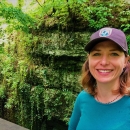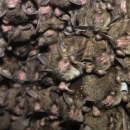Approved Programs
(updated April 14, 2025)
Evaluation of software for use in Indiana bat (Myotis sodalis; MYSO, aka IBAT), northern long-eared bat (Myotis septentrionalis; MYSE, aka NLEB), and tricolored bat (Perimyotis subflavus; PESU, aka TCB) presence/probable absence (p/a) acoustic surveys is a collaborative effort between the U.S. Fish and Wildlife Service (Service/USFWS) and the U.S. Geological Survey (USGS), Virginia Cooperative Fish and Wildlife Research Unit (VCFWRU).
Performance criteria needed to achieve software approval are set by the Service, with input from experienced bat ecologists, statisticians, and regulatory specialists. For software to be reviewed and tested, developers must submit their program along with an official submittal form (available on the Service’s Automated Acoustic Bat ID Software Program webpage)1 to the Service. Developers may submit software to the Service to be tested at any time and at no cost. All submissions and inquiries regarding software testing must be directly made to the Service. Once submitted to the Service, the submittal form will be reviewed, and if complete, the software package and submittal form will be accepted for official testing. If the Service determines the submittal package is not complete, we will communicate with the developer to address before testing can move forward. Test results will be provided to the software developers with the Service’s determination. In the interest of improving software performance, the Service will discuss results with software developers. However, the Service asks that software developers not use the review process as a beta-testing platform. The software testing process can, in some cases, be lengthy for a variety of reasons (e.g., new software program submitted that requires tweaks to testing procedures, failed tests resulting in modifications and resubmittal of software, Service Staff availability, etc.).
Table 1. U.S. Fish and Wildlife Service approved software, settings, and formats (last updated 3/31/2025).
Software | Version | Classifier(s) | Approved Settings2 | Approved Species | Approved Recording Formats6 |
|---|---|---|---|---|---|
BCID | 2.8 | Eastern USA | Default settings, but special conditions may apply. 3 | MYSO, MYSE, PESU | ZC |
Kaleidoscope Pro | 5.7.01 | NA 5.7.03 | Default Settings with zero and -1 sensitivity, but special conditions may apply.3 | MYSO, MYSE, PESU | ZC and FS |
SonoBat5 | 30.11 & 30.21 | All classifiers within the Midwest, Northeast, Southeast, Florida, Regional Packs3, 4 In the Texas Regional Pack: Eastern TX & nEastern TX Classifier. In the Dakota Regional Pack: Eastern Dakota & SE Dakota Classifier. | Default Settings (32 pulses, 0.60 acceptable call quality, 0.90 sequence decision threshold) but special conditions may apply.3 | MYSO, MYSE, PESU
| FS |
1 Wildlife Acoustics and SonoBat routinely issue new updated versions of their software programs to address various user interface and compatibility issues that have no impact on the program’s species classification. The USFWS will continue to formally test only new versions of KPro and SonoBat that include any changes to the underlying classifier that could change the species identification outcomes. We will automatically approve new versions of KPro and SonoBat provided that they use the same classifier from the most recently tested and approved versions. For example, we are approving and pre-approving all KPro versions issued after version 5.7.0 that use the 5.7.0 Bats of U.S. and Canada classifier.
2 When provided as an option, users are to select the most appropriate species assemblage/geographic region, which include MYSO and/or MYSE, and/or TCB and all other species that may reasonably occur in a given survey area/region. The entire species assemblage should be submitted with the Site Study Plan to the USFWS Field Office reviewing the plan, and that same species assemblage must be used during data analysis.
3During our most recent internal software testing (and consistent with findings from independent sources such as Solick et al. 2025, in press), we found that the versions of auto-ID software programs being tested do not reliably provide a MLE p-value of <0.05 for rare target species when they are present in low numbers at the night level (<15 files per site night). Regardless of MLE value, if there are any files identified as the target species, either assume presence and coordinate with the USFWS FO(s) or conduct qualitative analysis of files to confirm or reject presence for the species of interest, as outlined below.
Table 2. Possible automated software Maximum Likelihood Estimation (MLE) outcomes at the Site-Night level and options for next steps.
| Possible Outcome at Site-Night Level: | Next Step(s): |
| #1. Software identified 0 files to target species | Accept result for site-night (species is absent). |
| #2. Software identified ≥1 files to target species & MLE p-value is <0.05 | Accept result for site-night (target species is present) OR conduct visual review to determine if result is false positive. |
| #3. Software identified ≥1 files from target species & MLE p-value is >0.05 | Disregard p-value. Assume presence OR conduct visual review to determine if result is false negative for target species. |
CONDUCTING VISUAL REVIEW
IBAT and NLEB:
If using KaPro or BCID: First review all files labeled as IBAT and/or NLEB. If the target species is not confirmed, review all other files in folders containing pulses with characteristic frequency ≥ 38 kHz, including those in the NOID folder.
If using SonoBat: Review files labeled as the target species in the “Spp Accp” (Species Accepted) column. If species is not confirmed at this step, next review files identified as potentially belonging to target species in the “~Spp” (Leaning Species) column (e.g. MYSO, MYSO/other species).
TCB:
If using KaPro or BCID: First review all files labeled as TCB. If the target species is not confirmed, review all other files in folders containing pulses with characteristic frequency ≥ 40 kHz, including the NOID folder.
If using SonoBat: Review files labeled as the target species in the “Spp Accp” (Species Accepted) column. If species is not confirmed at this step, next review files identified as potentially belonging to target species in the “-Spp” (Leaning Species) column (e.g. PESU, LABO/PESU).
4In SonoBat, files classified to the “LUSO” category contain files that could belong either to Indiana or little brown bat. Therefore, these files should be treated as possible Indiana bat recordings and conditions outlined above in #3 for Indiana bat also apply to the LUSO category. For example, if SonoBat assigns 15 files to LUSO with an MLE p-value of 0.01, presence for Indiana bat can be assumed unless qualitative analysis is conducted and Indiana bat classifications are rejected.
5Quick Start Guides on how to generate the Site-Night (night level) MLE p-values and how to visually confirm or reject target species presence from the Batch Classification report in SonoBat can be found on this website. Available SonoBat guidance for surveyors includes a SonoBat30 post-processing flow-chart and SonoBat30 detailed post-processing guidance for P/A surveys document. These resources were provided courtesy of J.D. Tyburec with Bat Survey Solutions LLC.
6ZC= Zero-cross, FS= Full-spectrum
Candidate Program
The candidate program below has not yet been tested/re-tested and therefore is not approved by USFWS for stand-alone use for TCB, MYSO and/or MYSE P/A surveys in all or parts of the range. In the interim, one or more of the candidate programs below may be used in conjunction with one or more of the “approved” programs for TCB, MYSO and/or MYSE P/A surveys.
EchoClass (Eric Britzke, ERDC)
The Service funded Dr. Eric Britzke with the U.S. Army Engineer Research and Development Center in Vicksburg, Mississippi to develop an automated acoustic bat identification software program suitable throughout the range of the Indiana bat. Version 3.1 is publicly available for use (free of charge) and may be downloaded from these links.
Software Developers
Software developers wishing to have their program/new versions evaluated by the Service should complete this submittal form and send it to Vona Kuczynska (vona_kuczynska@fws.gov) in the Missouri ES Field Office and Mike Armstrong (mike_armstrong@fws.gov) in the Kentucky ES Field Office.
How to Contribute Additional Call Files to the Master Test Library
In the interest of improving the overall number and diversity of acoustic files included in the Master Test Library, the Service encourages qualified individuals to voluntarily contribute additional full spectrum files of known species. Data will be considered for inclusion if species identity is unequivocally known. Passively collected and manually identified files may be considered on a case-by-case basis pending discussion with the Service. Files used by developers to train software programs should not be submitted for inclusion in the Master Test Library. To permit future development of software testing (e.g. regional test libraries), contributors are requested to include relevant metadata along with their file submissions using the submittal form here.
If you are interested in contributing known call files to the Master Test Library, please contact Vona Kuczynska (vona_kuczynska@fws.gov) or Mike Armstrong (mike_armstrong@fws.gov).






